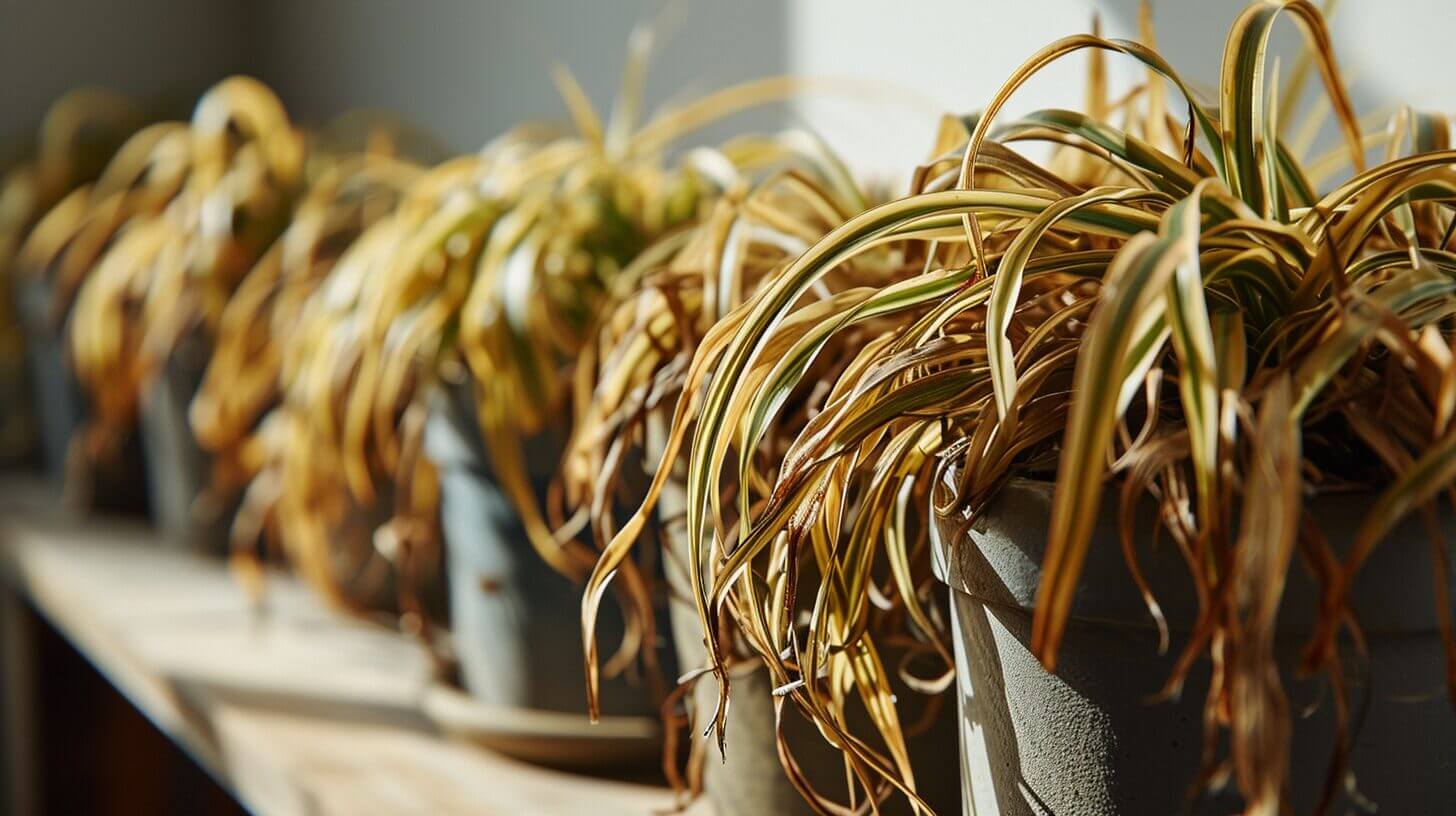Did you know that yellowing leaves are one of the most common problems faced by spider plant owners? In fact, over 70% of spider plant owners have experienced this issue at some point.
If you’re one of them, don’t worry – we’re here to help. In this article, we will explore the various causes of yellowing spider plant leaves and provide you with practical tips and solutions to address this problem.
So, let’s dive in and restore the vibrant green color to your beloved spider plant.
Key Takeaways
- Yellowing spider plant leaves can be caused by overwatering, pests and diseases, over-fertilization, and insufficient light.
- Light is crucial for spider plant health, and they thrive in bright, indirect light. Direct sunlight can damage the leaves, while low light conditions may affect growth and leaf color.
- Proper watering habits are important for spider plant leaf color. They prefer well-draining soil and should be watered when the top inch of soil feels dry. Waterlogged soil should be avoided to promote healthy growth.
- Nutritional deficiencies can lead to yellowing leaves. Lack of essential nutrients, poor soil quality, improper fertilization, or inadequate nutrient absorption can contribute to deficiencies. Treatment options include balanced fertilization, adjusting watering and light conditions, and ensuring proper soil pH.
Common Causes of Spider Plant Leaves Turn Yellow
One of the most common causes of yellowing spider plant leaves is overwatering. Overwatering can lead to root rot and nutrient deficiencies, both of which can cause the leaves to turn yellow. It is important to water spider plants only when the top inch of soil feels dry to the touch.
Another factor that can contribute to yellowing leaves is pests and diseases. Spider mites, aphids, and mealybugs are common pests that can infest spider plants and cause discoloration. Regularly inspecting the plant for signs of pests and promptly treating them can help prevent yellowing leaves.
Additionally, over-fertilization can also impact the color of spider plant leaves. Excessive fertilizer can cause nutrient burn, leading to yellowing and browning of the leaves. It is crucial to follow the recommended fertilization schedule and use a balanced fertilizer specifically formulated for spider plants.
Understanding the Role of Light in Spider Plant Health
To maintain optimal spider plant health, it is crucial to understand the role of light and how it affects the plant’s growth and leaf color.
Light is essential for photosynthesis, the process by which plants convert light energy into chemical energy to fuel their growth. Spider plants thrive in bright, indirect light. Placing them near a north-facing window or providing them with filtered sunlight is ideal. However, direct sunlight can scorch their leaves, so it’s important to avoid exposing them to intense rays.
Additionally, spider plants are tolerant of low light conditions but may not grow as vigorously or produce as many leaves. In terms of leaf color, insufficient light can cause the leaves to turn pale or yellow. If your spider plant is not receiving enough light, consider moving it to a brighter location.
Remember to rotate the plant occasionally to ensure even exposure to light. By understanding the light requirements of spider plants, you can ensure their health and vibrant leaf color.
The Impact of Watering Habits on Spider Plant Leaf Color
Regularly watering your spider plant is essential for maintaining its leaf color and overall health. Proper watering habits can prevent the negative effects of overwatering, which can cause yellowing of the leaves. Here are some tips for watering your spider plant:
- Avoid overwatering: Spider plants prefer well-draining soil, so make sure not to let the water sit in the bottom of the pot. Excess moisture can lead to root rot and yellowing leaves.
- Water when the soil is dry: Check the top inch of the soil and water your spider plant only when it feels dry to the touch. This will prevent waterlogged soil and promote healthy growth.
- Use room temperature water: Avoid using water that is too cold or too hot, as extreme temperatures can shock the plant and affect its leaf color.
- Consider the environment: Factors like temperature, humidity, and sunlight can affect the water needs of your spider plant. Adjust your watering schedule accordingly.
Nutritional Deficiencies and Yellowing Spider Plant Leaves
The yellowing of spider plant leaves can be attributed to nutritional deficiencies that hinder the plant’s ability to maintain its vibrant green color. Common causes of nutritional deficiencies in spider plants include a lack of essential macronutrients such as nitrogen, phosphorus, and potassium, as well as micronutrients like iron and magnesium. These deficiencies can occur due to poor soil quality, improper fertilization, or inadequate absorption of nutrients by the plant’s roots.
If left untreated, the yellowing leaves may continue to deteriorate and impact the overall health of the plant. However, there are treatment options available to address these nutritional deficiencies and restore the plant’s health. By providing a balanced fertilizer, adjusting watering and light conditions, and ensuring proper soil pH, you can help your spider plant regain its vibrant green color.
Now, let’s explore how to treat and prevent yellowing spider plant leaves.
How to Treat and Prevent Yellowing Spider Plant Leaves
With proper care and attention, you can effectively treat and prevent yellowing spider plant leaves. Here are some practical tips to help you maintain a healthy spider plant:
- Pruning: Regularly prune your spider plant by removing any yellow or brown leaves. This will encourage new growth and prevent the spread of diseases.
- Proper watering: Spider plants prefer to be kept evenly moist, but not waterlogged. Water your plant when the top inch of soil feels dry, and make sure to drain any excess water from the saucer.
- Lighting: Spider plants thrive in bright, indirect light. Place your plant near a window where it can receive ample sunlight, but avoid direct sunlight as it can scorch the leaves.
- Avoid overfertilizing: Spider plants are not heavy feeders. Use a balanced, water-soluble fertilizer once a month during the growing season, following the instructions on the label.
Frequently Asked Questions
Can Spider Plants Survive in Low Light Conditions?
Spider plants have a remarkable ability to survive in low light conditions. While they thrive in bright, indirect light, they can tolerate lower light levels. However, it’s important to note that in low light conditions, spider plants may not grow as vigorously and their leaves may appear slightly pale or yellow.
To ensure their survival, it’s recommended to place spider plants near a window or provide them with artificial lighting to compensate for the lack of natural light.
How Often Should Spider Plants Be Watered?
Spider plant care involves proper watering to prevent the leaves from turning yellow. Overwatering is a common mistake that can lead to this issue. To determine the frequency of watering, consider the plant’s environment and soil moisture.
Spider plants prefer slightly moist soil, but it is crucial to allow the top inch of soil to dry out before watering again. By finding the right balance, you can ensure the health and vibrant green color of your spider plant leaves.
Can Overwatering Cause Yellowing Leaves in Spider Plants?
Overwatering can have detrimental effects on spider plants, leading to yellowing leaves. Signs of overwatering include wilting, root rot, and yellowing or browning of the leaves. It is important to strike a balance with watering spider plants, as they prefer slightly dry conditions.
To avoid overwatering, allow the soil to dry out between waterings and ensure proper drainage. Providing adequate sunlight and avoiding excessive fertilization can also help maintain the health of spider plant leaves.
Are Brown Tips on Spider Plant Leaves Related to Yellowing Leaves?
Spider plants require specific nutrients to maintain healthy leaf color. Nutrient deficiencies can be a common cause of yellowing leaves in spider plants.
It is important to ensure that spider plants are receiving the necessary nutrients, such as nitrogen, phosphorus, and potassium, through proper fertilization. Inadequate levels of these nutrients can lead to yellowing leaves.
It is recommended to use a balanced fertilizer specifically formulated for indoor plants to provide the necessary nutrients and promote healthy leaf color in spider plants.
Are There Any Natural Remedies or Homemade Solutions to Treat Yellowing Spider Plant Leaves?
If you’re looking for natural remedies or homemade solutions to treat yellowing spider plant leaves, there are several options you can try.
One effective method is to use a mixture of water and mild liquid soap to gently wipe the leaves, removing any dust or dirt that may be causing discoloration.
Another solution is to create a natural fertilizer using coffee grounds and banana peels, which can provide essential nutrients to the plant.
These remedies can help revive your spider plant and promote healthy leaf color.







